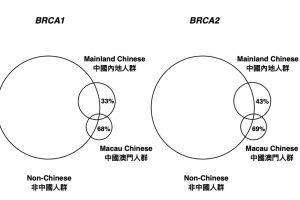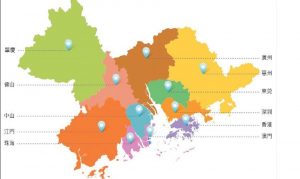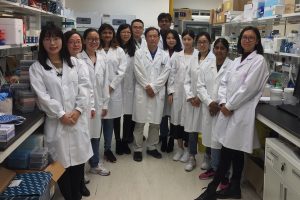One in eight women will develop breast cancer over the course of a lifetime. Breast cancer is the most common cancer in women worldwide, as well as the most commonly-occurring cancer in women in Macao. In view of this alarming trend, how can medical research prevent breast cancer?
The Threat of Breast Cancer
Breast cancer is a significant threat to women’s health. In 2018, over 2 million women worldwide, and over 250,000 in China, were diagnosed with breast cancer. Around 10 to 15 per cent of breast cancer cases are caused by hereditary genetic mutations transmitted following Mendelian genetics. The majority of the mutations are located in BRCA1 and BRCA2 genes (BRCA), which are the essential genes for maintaining genome stability. Women carrying pathogenic mutations in BRCA1 have up to 80 per cent of lifetime risk of developing breast cancer. Mutations in BRCA genes also increase the risk of developing other types of cancer, including ovarian, prostate, and pancreatic cancers.
Effective Prevention Method
Identification of BRCA mutation carriers before cancer occurrence is the most effective way to prevent mutation carriers from cancer, as it allows early cancer surveillance, targeted drug prevention, preventive surgery, and interrupts mutation transmission to the next generation through in vitro fertilisation. With the known cause of genetic mutation, available methods to identify the genetic mutation, and multiple effective prevention and treatment options, BRCA mutation-caused cancers are the most preventable cancers among all cancer types in humans. The story of the American actress Angelina Jolie provides a vivid example of the relationship between BRCA mutation and breast cancer prevention.
Studies of BRCA Mutations
Recent studies have revealed that BRCA mutation in humans is highly ethnic-specific, that is, different ethnicities have very different mutations in BRCA genes. For example, BRCA mutations in Latin Americans are highly heterogeneous, whereas BRCA mutations in Asians differ substantially from those in Caucasians. Ethnic-specific BRCA mutation is important, as it reflects the genetic basis for the cancer occurring in different ethnic populations, and provides specific mutation targets for precise identification of the mutation carriers for prevention, diagnosis and treatment of the cancer in given ethnic populations. However, the BRCA mutation data widely used in clinical applications are mostly derived from Caucasian populations in Europe and North America, which account for only a small portion of the total human population, whereas the data from non-Caucasian ethnicities, which account for 80 per cent of world population, are rare.
BRCA Mutation Database
Our laboratory has been studying BRCA mutations in the Chinese population. Through comprehensive data analysis, we have collected over 1,000 BRCA mutations from over 30,000 Chinese cancer patients. This is the most comprehensive BRCA mutation data that originated from the Chinese population, and one of the largest from a non-Caucasian population. We have developed an open-access database, Chinese BRCA mutation database, for public use (https://dbBRCA-Chinese. fhs.umac.mo). Through comprehensive comparison with BRCA mutation data from non-Chinese populations around the world, we have determined that 40 per cent of the Chinese BRCA mutations are only present in the Chinese population but not in non-Chinese populations.
BRCA Mutations in Macao
We further analysed BRCA mutations in Macao. Macao has a population of over 600,000, in which over 50 per cent are female, and 95 per cent are of Chinese ethnicity and predominantly Cantonese. Breast cancer is the most commonly occurring cancer of all cancer types in females in Macao, with 1,353 breast cancer cases diagnosed between 2003 and 2013. Through analysing 2,000 individuals in Macao, we observed a higher frequency of BRCA mutations in the Macao population than in other populations. This suggests that BRCA mutations can play a more significant role in breast cancer in the Macao population than in other populations (Fig.1). A significance of studying the population in Macao is that the data can be readily applicable to the population in the Greater Bay Area, including Guangdong, Hong Kong, and Macao. The population in the Greater Bay Area is a subgroup of the Chinese population known as Lingnan, whose genetic background is known to be substantially different from that of the inland Chinese population. As Macao’s population is genetically the same as people in the Greater Bay Area, the ethnic-specific BRCA mutation identified in the Macao population should be the same as the population in the Greater Bay Area. Therefore, Macao’s population provides a perfect model to study BRCA mutation in the population of the Greater Bay Area, and the BRCA mutations identified in the Macao population are readily applicable for cancer prevention and treatment in the entire area inhabited by a population of over 100 million, in which systematic investigations into BRCA mutations have been very limited. We are working hard in this direction, including expanding the coverage of testing in the Macao population and conducting large-scale verification work in the Guangdong population. Our work should lay a solid foundation for cancer prevention through promoting BRCA gene mutation screening for the population in the Greater Bay Area.
Note: This is the first large open-access Chinese BRCA mutation database, which contains data on almost all known BRCA mutations found in the Chinese population. This is also one of the largest non-Caucasian single-country BRCA mutation databases. It is the hope of the Faculty of Health Sciences that this database will promote the study of BRCA-related cancers in the Chinese population and the clinical applications of the research results, and enhance domestic and international collaboration in the field.
Source: UMagazine Issue 20



